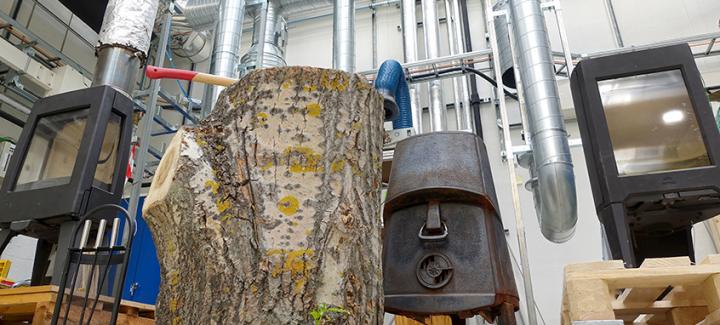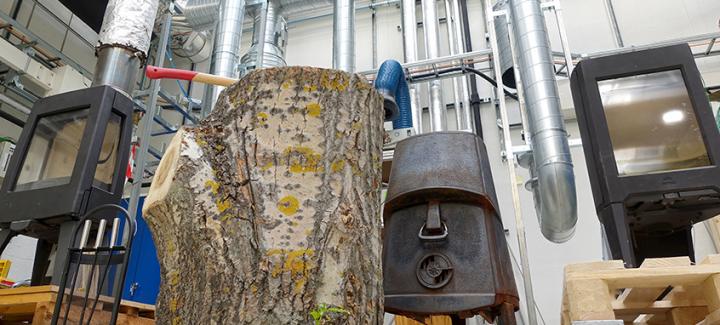
Credit: SINTEF Energy
Norwegians love to heat with wood. That's easy to see when driving around the Norwegian countryside in the winter. Stacks of wood line the walls of houses and smoke rises from the chimneys, especially on cold days.
There was even a national "wood night program" on NRK, the Norwegian Broadcasting Corporation, which ran for 12 hours and attracted international attention because of its unusual theme.
According to figures from Statistics Norway (SSB), 1.2 million Norwegian households heat with wood. They burned 1.1 million tonnes of firewood in 2016, which provided 5.34 TWh of direct heat — and that might have affected the climate more than you might think.
"Our findings show a complex picture. This form of heating has a significant warming effect on the climate, which is cause for concern. But at the same time, burning wood also causes significant cooling, which is encouraging," says Anders Arvesen, a researcher in the Industrial Ecology Programme at the Norwegian University of Science and Technology (NTNU).
Arvesen and his colleague Francesco Cherubini were among the co-authors of a major study on climate impacts in Norway just published in Scientific Reports.
The study analyzed so-called stationary bioenergy systems based on heat from wood-burning stoves and from wood biomass-based district heating.
"A lot of research has been done on this topic, but until now we've never had such a comprehensive study of various effects on a national level. This is the first time we've considered all the different factors in a single study," says Cherubini, who is a professor at NTNU's Industrial Ecology Programme.
A research project called CenBio, which focused on innovations in bioenergy, carried out the study, which was supported by NTNU in cooperation with SINTEF Energy, the Norwegian Institute of Bioeconomy Research (NIBIO) and the Norwegian University of Life Sciences (NMBU).
The 35 members of the OECD decided in 1991 that CO2 emissions from biomass combustion would not count in CO2 emission accounting. The theory was that nature would reabsorb the carbon dioxide released by burning, yielding a net balance of zero. Unfortunately it's not quite that simple.
"Bioenergy from forests is carbon neutral in the sense that forests are a renewable resource. The trees will absorb CO2 as they grow, but temporarily there will be a greater amount of CO2 in the atmosphere," explains Arvesen.
Logging can adversely affect the climate, including from emissions from heavy logging machinery. But the logged areas themselves can actually have a cooling effect, because open areas reflect more of the incoming sunlight back into the atmosphere than wooded areas.
"The cooling effect varies depending on where in the country the logging takes place, since different parts of the country have varying snow conditions and forest density," says Arvesen.
The CenBio study took these factors into consideration. It also analysed how other emissions from burning wood affect the climate. Methane gas and assorted particles also flow out of Norwegian chimneys.
These particles can both absorb and reflect solar radiation. Whereas organic carbon particles have a cooling effect, black carbon – also known as soot – has a warming effect on the climate.
Black carbon also destroys some of the snow's ability to reflect sunlight because it changes the colour of the snow landscape and contributes to increased snowmelt.
Black carbon from biomass combustion accounts for 1.6 million tonnes of CO2 in Norway, according to the study.
"Our analysis indicates that black carbon is the main reason for climate warming. I was surprised how important the effect of soot was, although it wasn't completely unexpected. Burning wood creates a lot of dust emissions," says Arvesen.
Cherubini thinks more research is needed in this area. He points out that reducing black carbon emissions will also have a positive health effect due to improved air quality.
Nevertheless, "it's still better to heat with wood than to burn fossil fuels," says Cherubini. He emphasizes that more technological possibilities are being developed that will result in new and better wood stoves and furnaces. Until they come on the market, people can reduce particle emissions by replacing their old stoves.
Many Norwegians have already replaced their old woodstoves with newer and cleaner-burning stoves, which has more than halved soot emissions since the early 2000s.
By 2016, 730 000 wood-burning households were using new technology. Overall, heating with wood in Norway has decreased slightly. The amount of wood burned in furnaces with old technology has decreased by more than 75 per cent in the past 20 years, according to Statistics Norway.
Old woodstoves emit more black carbon than new ones. And if the positive development continues, woodstove emissions should drop to the same level as pellet stoves in the near future. The challenge lies in the smallest particles, according to SINTEF scientist Morten Seljeskog.
"Soot is made up of particles as small as nanosize. These emissions are the most difficult ones to get rid of. Researchers are working to figure out what physical measures need to be taken in the combustion chamber to minimize soot emissions in all furnaces," he says.
###
Media Contact
Francesco Cherubini
[email protected]
47-735-98942
@NTNU
http://www.ntnu.edu
Related Journal Article
http://dx.doi.org/10.1038/s41598-018-21559-8





